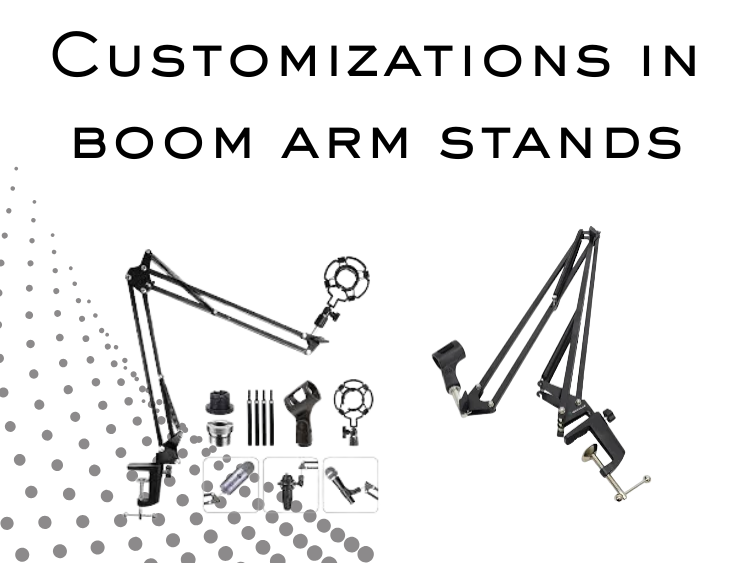Your mic stand shouldn’t dictate how you work—you should dictate how your mic stand works. That’s the shift happening in the world of boom arm mic stands.
Gone are the days of rigid, one-size-fits-all designs. Today, customization is king. Whether you need a longer reach, smoother adjustments, or a stand that actually matches your studio’s aesthetic, the options are endless.
Musicians, podcasters, and streamers aren’t settling for just any setup. They’re tweaking, modifying, and upgrading to get the perfect mic placement every time. And manufacturers are keeping up, rolling out features designed to adapt to you—not the other way around.
So, what’s driving this wave of personalization? Let’s dive into the trends shaping the future of boom-arm mic stands.
Why Customization Matters in Boom Arm Mic Stands?
A mic stand should adapt to you—not the other way around. Whether you’re a musician, podcaster, or content creator, the ability to fine-tune your setup can mean the difference between frustration and seamless performance. Customization isn’t just about looks; it’s about efficiency, comfort, and long-term usability.
- Personalized Positioning – A stand that adjusts to your exact needs reduces strain and ensures optimal mic placement. Whether recording while seated, standing, or switching between both, customization improves ergonomics.
- Optimized for Workflows – Different users have different needs. Musicians require flexibility for instrument positioning, podcasters need stability for consistent audio, and streamers want a clutter-free workspace. Custom features accommodate these specific demands.
- Aesthetic & Brand Identity – A mic stand is part of your creative space. Custom finishes, color options, and premium materials allow users to match their setup to their personal or professional brand.
If you want to know more, find a detailed idea here: Are boom stands better than straight sands?
Key Customization Trends in Boom Arm Mic Stands
Now that we know why the customizations in a mic stand are important, let’s look at all the possible customizations we can possibly make.
Adjustable Length and Angles
One of the biggest shifts in boom arm design is enhanced flexibility. Customization now goes beyond simple height adjustments—users demand mic stands that move effortlessly and hold positions securely.
- Multi-Axis Rotation – Stands with 360-degree movement let users position their mics at any angle for ideal sound capture.
- Telescopic Arms – Extendable arms offer greater reach, making them perfect for larger desks or dynamic recording setups.
- Quick-Lock Mechanisms – Fast adjustments and secure locking systems prevent mic drift during long sessions.
Modular Attachments & Accessories
Customizable boom arms now feature modular designs, allowing users to add or remove components based on their specific needs. This means fewer compromises and more tailored setups.
- Clamp-on Extensions – Additional arms for secondary mics, pop filters, or even cameras enhance multi-purpose use.
- Cable Management Clips – Built-in clips and channels keep wires organized, reducing clutter and preventing tangles.
- Integrated Shock Mounts – Advanced vibration-dampening mounts help maintain clean audio quality, even in energetic environments.
Material and Finish Customization
A mic stand’s build isn’t just about durability—it impacts weight, mobility, and even aesthetics. Users are now looking for materials that balance stability, portability, and visual appeal.
- Lightweight Aluminum vs. Sturdy Steel – Aluminum stands offer easy maneuverability without sacrificing strength, while steel provides maximum durability for heavier mics.
- Matte vs. Glossy Coatings – Matte finishes reduce glare for video recordings, while glossy coatings add a sleek, premium look.
- Anti-Rust & Powder-Coated Options – Protective coatings extend lifespan, making stands resistant to humidity, dust, and wear.
Choosing the right material isn’t just about looks—it’s about creating a long-lasting, functional setup that enhances usability.
Foldable & Space-Saving Designs
Not every workspace has room for a bulky mic stand. With compact studios and mobile setups becoming more common, space efficiency is a priority.
- Compact Folding Mechanisms – Modern stands collapse into smaller sizes for easy storage and transport.
- Detachable Parts – Quick-assembly designs allow users to remove or swap components based on their needs.
- Wall-Mountable & Desk-Clamp Models – Instead of taking up floor space, users can opt for stands that attach to surfaces, freeing up room for other gear.
Spring vs. Friction-Based Adjustment Systems
The way a boom arm moves is just as important as where it moves. Users want mic stands that adjust effortlessly yet stay locked in place when needed. This has led to innovations in tension control mechanisms.
- Spring-Loaded Arms – Ideal for quick, responsive adjustments. They provide smooth motion and hold their position well, making them a popular choice for broadcasters and streamers.
- Friction-Based Systems – These offer finer control without sudden movements. Perfect for musicians and podcasters who need gradual, precise positioning.
- Hybrid Mechanisms – Some high-end stands now combine both systems, offering the best of both worlds—fluid motion with strong hold.
Choosing the right adjustment system ensures stability without constant readjustments, keeping focus on content rather than equipment. Learn more in our dedicated article on Adjusting mic stand height for different applications.
The Rise of Smart Boom Arm Stands
Technology is creeping into every aspect of gear customization, and mic stands are no exception. Smart boom arms are beginning to change how users interact with their setups.
- Built-In LED Indicators – Some high-end models now feature visual indicators for mute status, volume levels, or mic placement guidance.
- Integrated USB & XLR Ports – Direct connectivity allows for cleaner setups without extra cables running across desks.
- Auto-Tension Adjustment – Future mic stands may adapt automatically to mic weight, eliminating manual fine-tuning.
If you want to know about how you can save a few extra bucks while purchasing your next mic stand, read How to save money while buying mic stands.
Conclusion
Customization is no longer just a premium feature—it’s becoming the industry standard. From adjustable angles to smart features, modern boom arm mic stands are evolving to meet the needs of musicians, streamers, and content creators alike.
As ergonomics, space efficiency, and tech integration continue to drive innovation, future models will likely push boundaries even further. Expect more hybrid adjustment systems, modular add-ons, and even AI-driven optimizations.
Investing in a customizable mic stand isn’t just about convenience—it’s about enhancing performance, comfort, and creative workflow. The future is all about tailoring gear to the user, not the other way around.



